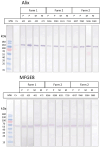Micro RNA profiles in colostrum exosomes obtained from primiparous or multiparous dairy cows
- PMID: 39545260
- PMCID: PMC11561390
- DOI: 10.3389/fvets.2024.1463342
Micro RNA profiles in colostrum exosomes obtained from primiparous or multiparous dairy cows
Abstract
Colostrum is rich in membranous vesicles of endocytic origin named exosomes, with proteins, lipids, RNA, and/or DNA cargos which can play different roles in physiological processes. Like other colostrum bioactive compounds, exosomes could be also influenced by individual characteristics. The objective of the study was to characterize miRNA cargo of colostrum exosomes from primiparous and multiparous cows in different farms. Twenty-seven colostrum samples of clinically healthy Holstein cows (11 primiparous and 16 multiparous) from 3 different farms were obtained and frozen. After thawing, exosomes were isolated following an ultracentrifugation protocol, and characterized morphologically. Particle size distribution and western immunoblotting were also analyzMaed. After RNA extraction, miRNAs were sequenced and analyzed to assess potential differences in profiles between primiparous and multiparous cows from different farms. Fourteen miRNA were upregulated and 11 miRNAs downregulated in primiparous compared with multiparous cows. Most of the miRNA differences between primiparous and multiparous cows regulate the gene expression of factors involved in mammary gland development and differentiation, and lipogenesis. In addition, miRNAs from one of the farms showed 8 miRNAs downregulated and 12 upregulated compared with the other 2 farms, independently of parity. Differences in miRNA between farms were mainly associated with immune and inflammatory-related genes. In conclusion, miRNA cargos of bovine colostrum exosomes differ in primiparous and multiparous cows, and some on-farm practices might also determine the content and activity of miRNA in colostrum exosomes.
Keywords: colostrum; dairy cow; exosome; miRNA; parity.
Copyright © 2024 Terré, Arís, Garcia-Fruitós, Fàbregas and Bach.
Conflict of interest statement
The authors declare that the research was conducted in the absence of any commercial or financial relationships that could be construed as a potential conflict of interest. The author(s) declared that they were an editorial board member of Frontiers, at the time of submission. This had no impact on the peer review process and the final decision.
Figures




Similar articles
-
Colostrum from primiparous Holstein cows shows higher antioxidant activity than colostrum of multiparous ones.J Dairy Res. 2020 Aug;87(3):356-359. doi: 10.1017/S0022029920000813. Epub 2020 Sep 7. J Dairy Res. 2020. PMID: 32893763
-
Milk yield and milking station visits of primiparous versus multiparous cows on automatic milking system farms in the Upper Midwest United States.J Dairy Sci. 2019 Apr;102(4):3523-3530. doi: 10.3168/jds.2018-15382. Epub 2019 Jan 26. J Dairy Sci. 2019. PMID: 30692000
-
Rapid Communication: Colostrum immunoglobulin concentration in mammary quarters is repeatable in consecutive lactations of dairy cows.J Anim Sci. 2016 Apr;94(4):1755-60. doi: 10.2527/jas.2016-0362. J Anim Sci. 2016. PMID: 27136032
-
Effect of oxytocin use during colostrum harvest and the association of cow characteristics with colostrum yield and immunoglobulin G concentration in Holstein dairy cows.J Dairy Sci. 2024 Sep;107(9):7469-7481. doi: 10.3168/jds.2024-24909. Epub 2024 May 31. J Dairy Sci. 2024. PMID: 38825098
-
Review: passive immunity in beef-suckler calves.Animal. 2019 Apr;13(4):810-825. doi: 10.1017/S1751731118003026. Epub 2018 Nov 21. Animal. 2019. PMID: 30458893 Review.
Cited by
-
Exosomal miRNAs: A New Frontier in Cardiovascular Disease Diagnosis and Treatment.J Cardiovasc Transl Res. 2025 Jun 19. doi: 10.1007/s12265-025-10617-y. Online ahead of print. J Cardiovasc Transl Res. 2025. PMID: 40536715 Review.
References
-
- McGrath BA, Fox PF. Composition and properties of bovine colostrum: a review. Dairy Sci Technol. (2016) 96:133–58. doi: 10.1007/s13594-015-0258-x - DOI
-
- Mann S, Leal Yepes FA, Overton TR, Lock AL, Lamb SV, Wakshlag JJ, et al. . Effect of dry period dietary energy level in dairy cattle on volume, concentration of immunoglobulin G, insulin, and fatty acid composition of colostrum. J Dairy Sci. (2016) 99:1515–26. doi: 10.3168/jds.2015-9926, PMID: - DOI - PubMed
LinkOut - more resources
Full Text Sources

